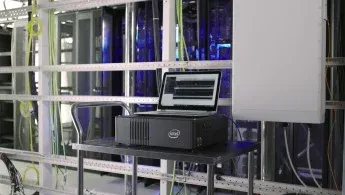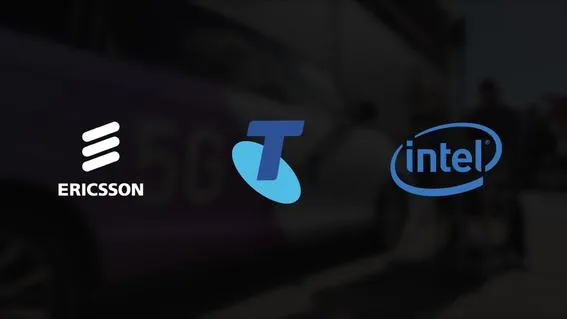5G will give operators the possibility to improve their existing consumer business and to address previously untapped value chains in the digitalization of industries. The new technology opens up new opportunities in new ecosystems. Ericsson is working closely with telecom operators across the world and has a large number of Memorandums of Understandings. Together with our partners we are continuously testing, learning and pushing the boundaries of how 5G can meet the diverse needs now and of the future.

Essential parts of the 5G standard have been completed with the approval of 5G New Radio (NR) specifications for non-standalone and standalone deployments of 5G. Ericsson is a key contributor to the standardization process. We are committed to rapidly applying these standards to our technology development and accelerate the commercial deployment of standard-based 5G networks.

First multi-vendor, end-to-end 5G commercial data call on 3.5GHz
Ericsson, Telstra and Intel have taken 5G out of the lab and into a real-world commercial production network to achieve the first 5G non-standalone (NSA) 3GPP end-to-end data call in a multi-vendor setup.
The data call was made over Telstra’s 5G NSA enabled commercial network over licenced 3.5GHz spectrum, using Ericsson’s 5G NR radio 6488, baseband and packet core for 5G EPC equipment integrated into Telstra commercial network and Intel® 5G Mobile Trial Platform for the 5G NR UE.
This latest milestone took place at Telstra’s 5G innovation centre on the Gold Coast in Australia. It quickly followed the July 6 lab-based data call by Ericsson and Intel, together with early-moving 5G service providers, at the Ericsson Lab in Stockholm.
Ericsson, Telstra and Intel achieve first end-to-end multi-vendor 5G commercial network data call over licenced 3.5GHz spectrum
Settings
Skip to content
Go to main navigation
Go to language selector
Search
Log in
NetworksShow submenu
Digital ServicesShow submenu
Managed ServicesShow submenu
PortfolioShow submenu
Technology & InnovationShow submenu
Trends & Insights
Contact us
About usShow submenu
CareersShow submenu
SustainabilityShow submenu
Latest newsShow submenu
Events
Press centerShow submenu
InvestorsShow submenu
Industry analystsShow submenu
Policy makersShow submenu
PartnersShow submenu
Follow us
Close
Find location
Algeria - en,fr
Angola - en
Antigua and Barbuda - en
Argentina - es,en
Australia - en
Azerbaijan - en
Bahrain - en
Bangladesh - en
Benin - en
Bhutan - en
Botswana - en
Brazil - pt,en
Brunei - en
Burkina Faso - en
Cameroon - en
Canada - en,fr
Central African Republic - en
Chile - es,en
China - zh,en
Colombia - es,en
Comoros - en
Congo (DRC) - en
Congo - en
Costa Rica - es,en
Croatia - en
Cuba - en
Djibouti - en
Dominican Republic - es,en
Egypt - en
El Salvador - es,en
Ethiopia - en
France - fr,en
Germany - de,en
Ghana - en
Guatemala - es,en
Haiti - en
Hong Kong - en
India - en
Indonesia - en
Iraq - en
Italy - it,en
Ivory Coast - en
Jamaica - en
Japan - en,ja
Jordan - en
Kenya - en
Kuwait - en
Lebanon - en
Liberia - en
Madagascar - en
Malaysia - en
Mali - en
Mauritius - en
Mexico - es,en
Myanmar (Burma) - en
Namibia - en
Nepal - en
New Zealand - en
Niger - en
Nigeria - en
Oman - en
Pakistan - en
Panama - es,en
Paraguay - es,en
Peru - es,en
Philippines - en
Poland - pl,en
Puerto Rico - es,en
Qatar - en
Russia - ru,en
Rwanda - en
São Tomé and Príncipe - en
Saudi Arabia - en
Senegal - en
Sierra Leone - en
Singapore - en
Somalia - en
South Africa - en
Spain - es,en
Sri Lanka - en
Suriname - en
Sweden - sv,en
Switzerland - en
Taiwan - zh,en
Tanzania - en
Thailand - en
Togo - en
Tunisia - en,fr
Turkey - tr,en
UAE - en
Uganda - en
Ukraine - en
United Kingdom - en
United States - en
Venezuela - es,en
Vietnam - en
Zambia - en
Ericsson worldwide
Home Networks Offerings 5G commercialization 5G partnerships 5G interoperability milestones
Network Functions Virtualization infrastructure
5G commercialization
4G evolution
Small cells
Transport
Cellular IoT
Network Intelligence & Automation
5g Services
Dynamic service manager
Technology milestones: showcasing 5G NR interoperability
Share on Twitter Share on Facebook Share on LinkedIn Share on Mail
5GNetworks
Essential parts of the 5G standard have been completed with the approval of 5G New Radio (NR) specifications for non-standalone and standalone deployments of 5G. Ericsson is a key contributor to the standardization process. We are committed to rapidly applying these standards to our technology development and accelerate the commercial deployment of standard-based 5G networks.
Mobile cell tower
First multi-vendor, end-to-end 5G commercial data call on 3.5GHz
Ericsson, Telstra and Intel have taken 5G out of the lab and into a real-world commercial production network to achieve the first 5G non-standalone (NSA) 3GPP end-to-end data call in a multi-vendor setup.
The data call was made over Telstra’s 5G NSA enabled commercial network over licenced 3.5GHz spectrum, using Ericsson’s 5G NR radio 6488, baseband and packet core for 5G EPC equipment integrated into Telstra commercial network and Intel® 5G Mobile Trial Platform for the 5G NR UE.
This latest milestone took place at Telstra’s 5G innovation centre on the Gold Coast in Australia. It quickly followed the July 6 lab-based data call by Ericsson and Intel, together with early-moving 5G service providers, at the Ericsson Lab in Stockholm.
Ericsson, Telstra and Intel achieve first end-to-end multi-vendor 5G commercial network data call over licenced 3.5GHz spectrum
Press release
5G NR standalone multi-vendor interoperability demonstrated
Ericsson and Intel together with China Mobile have successfully demonstrated the first 3GPP-compliant, multi-vendor Standalone (SA) 5G New Radio (NR) call. The interoperability demonstration followed the completion of the 5G NR Standalone specifications by 3GPP. The live demonstration with different players in the ecosystem marks another milestone on the path to 5G commercialization.
Following the 3GPP approval of the global 5G NR SA standard, Ericsson, Intel and China Mobile conducted a live Interoperability Development Testing (IoDT) of the newly approved technology. The live IoDT operating at 100MHz on 3.5GHz mid-band used Ericsson’s 5G NR base stations and Intel’s 5G NR UE (Intel® 5G Mobile Trial Platform) prototypes. The test achieved a downlink speed of over 1.3 Gbps.
The test complies with all key characteristics of the 3GPP 5G NR SA standard:
Multiple numerology support: Flexible OFDM (Orthogonal Frequency Division Multiplexing) waveform numerologies supporting low-band, as well as mid-band and high-band spectrum allocations for wideband operation and low latency services.
Flexible frame structure: Dynamic frame structure enables future-proof and ultra-lean design as well as self-contained data transmissions that support diverse use cases with requirements on, among others, low latency, high peak-rate, and high reliability with energy efficient transmission.
Channel codes: Channel coding schemes based on the latest technology in advanced low-density parity-check (LDPC); and Polar codes that support both extreme peak rates and high-reliability use cases.
Native MIMO support: Control and data channel support for Massive MIMO Multiple-input, Multiple-output) features based on beam-centric design; improves spectral efficiency and achieves higher data rates while boosting performance for consumers.
Ultra-lean design: Minimize any transmission not directly related to delivery of user data. Remove the need for always-on signals; more energy efficient design and reduces interference.
Expanded spectrum support: Low-bands, mid-bands, high-bands; more spectrum bands and wider bandwidth available.
The demonstration successfully carried out by the ecosystem partners is expected to accelerate the commercial deployment of standard-based 5G networks.
The Ericsson 5G NR radio used in the interoperability test
Maximum transmitting power 200 W
64 RF Channel
192 dual-polar antenna element
Frequency band 3.4 GHz – 3.6 GHz
Cell bandwidth 100 MHz
Sub-carrier distance 30 KHz
Frame Structure DDSU
Downlink support 256 QAMUplink support 64 QAM
Intel® 5G Mobile Trial Platform:
High performance FPGA platform, supports both Non-Standalone and SA;
Supports Sub-6 frequency band
Uplink support 2 layers and 256 QAMDownlink support 4 layers and 256 QAM
Credits : https://www.ericsson.com/en/networks/trending/hot-topics/5g-radio-access